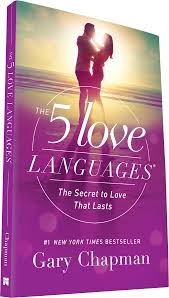The 5 Love Languages: The Secret to Love that Lasts

Gary D. Chapman, Northfield Publishing
How can couples who want to make their marriage work regain the loving feelings from earlier years? This is a question asked by many clients in couples therapy and obviously an excellent one. One challenge is that the whirlwind passionate experience of falling in love is magical — in part — due to its departure from and in some ways its rejection of day-to-day real life.
In his bestselling self help book, “The 5 Love Languages: The Secret to Love that Lasts”, anthropologist and marriage counselor Gary Chapman writes:
“We cannot take credit for the kind and generous things we do while under the influence of “the obsession.” We are pushed and carried along by an instinctual force that goes beyond our normal behavior patters. But if, once we return to the real world of human choice, we choose to be kind and generous, that is real love.”
Chapman proposes that people tend to fall into one of 5 distinct categories with respect for what makes them feel loved. Words of Affirmation, Quality Time, Receiving Gifts, Acts of Service and Physical Touch comprise the categories. Once the pixie dust of infatuation settles and couples embark on real life together, the challenge becomes that couples often do not speak or respond to the same love language. In other words, we tend to express love in the way we want to feel loved. But, all too often, one spouse feels love most acutely when love is expressed through the means of a category that may not be intuitive to his or her partner.
This no-nonsense, practical guide to marriage breaks down the five languages in a way that is easy to follow and can resonate well even with the most discouraged of couples. What is interesting in terms of the advice is that rather than a continuous series of compromises, Chapman urges readers to move past the idea that their love language is superior. In other words, whatever language your partner speaks is the one that you should use in order to make sure that they feel loved. If they respond to quality time, then it is essential to be willing to sometimes (or often) put your busy schedule on the back burner and make quality time your number one priority. If they respond to gifts, make sure you give them even if you find this approach superficial.
This strategy feels very much in concert to some basic communication advice I often give to clients: sometimes the best way to “win” and argument is to “lose” it. By this I mean that you can go on and on about the millions of reasons you may be “right” and likely get nowhere in terms of resolution. However, if you simply focus on where you are at fault and what you should have done differently, your partner will typically do the same. (And if genuinely owning your part of the problem does not generate a positive shift in the communications dynamic, this gives you some important information about the over-all relationship.)
Chapman’s Love Language advice is similarly self-focused and therefore effective. Rather than trying to prove to someone that they should feel satisfied because of all of the love you show in YOUR way, learn the ins and outs of their love language and become fluent in its dialect.
Chapman uses simple exercises and direct questions to help readers unsure of their language to determine which one resonates best. And the many case studies of couples he has helped in the past work as inspiring templates for those feeling stuck in a marital rut. Many of my clients have used this book as a complimentary tool alongside couples therapy. If “your love tank” is running on empty and you want to make your romantic relationship work, “The 5 Love Languages” is certainly a worthwhile, upbeat, enlightening read.
